
| THE AWARD |
| CATEGORIES |
| REGISTRATION |
| SUBMIT YOUR WORK |
| ENTRY INSTRUCTIONS |
| TERMS & CONDITIONS |
| PUBLICATIONS |
| DATES & FEES |
| METHODOLOGY |
| CONTACT |
| WINNERS |
| PRESS ROOM |
| GET INVOLVED |
| DESIGN PRIZE |
| DESIGN STORE |
| THE AWARD | JURY | CATEGORIES | REGISTRATION | PRESS | WINNERS | PUBLICATIONS | ENTRY INSTRUCTIONS |
A' Design Star |
Home > Benefits > Benefits to Winners > A' Design Star |
 A' Design Stars
A' Design Stars
A’ Design Star, a badge of honour, a highly coveted designation as well as a guide for good design, a hallmark of excellence in design, art, architecture and creativity.
Every year, the A’ Design Award & Competition picks out the most talented designers with outstanding, time-proven design quality and lists and publishes them as part of the A’ Design Star.
The primary purpose of the A’ Design Star designation is to help World’s leading brands, companies, institutions, governments and large agencies find, identify and select the best designers to work with, to procure outstanding design solutions from exceptionally talented designers, artists, architects, innovators and creators whose works and profiles have been assessed and rated to be exceptionally great, astoundingly prodigious, remarkably exceptional, and simply unsurpassable.
A’ Design Star is granted to exceptionally good award-winning designers that constantly and repeatedly deliver great results. A’ Design Star is a highly coveted designation that is only granted to concurrent, yet time-proven designers, artists, architects and creatives whose peers think they can be reliably trusted to create outstanding works for each and every single commission, work or project. If you work with a designer, artists, architect or creative with the coveted A’ Design Star designation, you will almost always get great results.
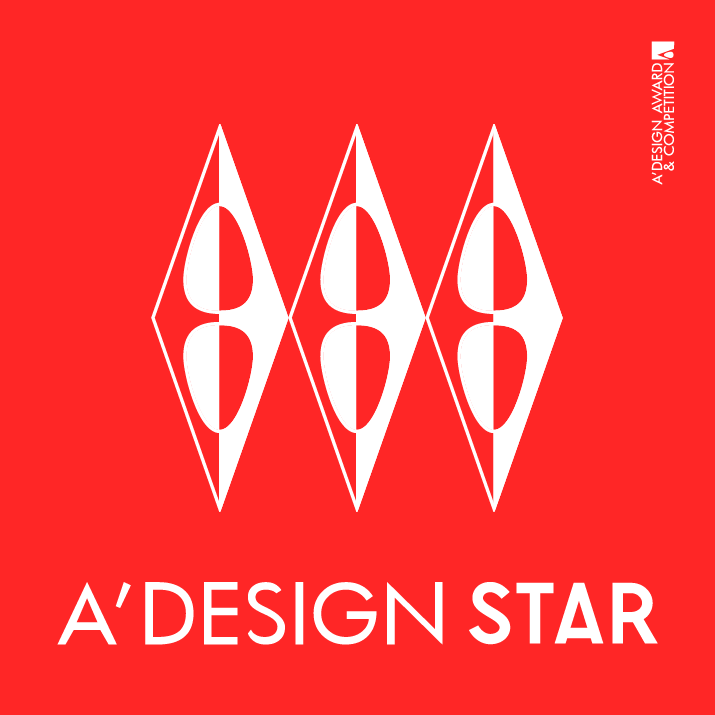
Acquiring the A’ Design Star designation is no small feat; it is a deed that requires endurance and ingenuity in creativity. While it is extremely hard to obtain the A’ Design Star designation, the procedure is equally simple, and well-documented. The general premise and prerequisite is to time-prove your design skills and capability by creating award-winning designs of the highest status, for at three consecutive years.
Under normal conditions, designers must follow the “Silver Procedure” and wait three years to obtain their award status as they would have to demonstrate consistency of skill over time. To obtain the A’ Design Star designation, the designers must win at least one Silver or higher such as Gold or Platinum A’Design Award, every year, for three years.
However, there are two expectations to this rule; if a designer, artist, architect or agency wins at least three A’ Platinum Design Awards within any given year, please note that this is indeed almost impossible to do so as it is really hard to win one, let alone three Platinum design awards, then the A’ Design Star designation would be granted within three months (Omega-3 / 8-Star rating), without waiting for three years; this is called “Platinum Procedure”. A’ Design Star could also be granted in two years instead of three years, if the designer had won at least three Gold A’ Design Awards, within the last two years (and at least a Gold or Platinum award for each of these years), and this is called the “Golden Procedure” and the rating (Omega-2 / 7-Stars) would be granted within two years, instead of three years.
Star Rating Assignment and Calculation
For the purpose of calculation of the exact star rating, the following formula is used: Platinum Award is given an equivalent value of 6, Gold Award is given an equivalent value of 5 (EV), Silver Award is given an equivalent value of 4, Bronze Award is given an equivalent value of 3, Iron Award is given an equivalent value of 2. First of all, for each award year, the highest achievement of the designer is taken into consideration and are summed-up to form the 3 year Score (S-Score). For 8-Star, Omega-3 rating, you need to have 16 or higher S-Score. For 7-Star, Omega-2 rating, you need to have 14 or higher S-Score. For Omega-1 rating, you need to have 12 or higher S-Score. It is not easy to obtain or maintain these scores, and therefore aspired by all but granted only to an excellent few, the A’ Design Star is a symbol of excellent design when it comes to finding the best designers, artists, architects, creatives, innovators, design studios, architecture offices, R&D centers and creative agencies.
The only way to acquire and keep the A’ Design Star designation is to have repeated high-level success, such as Platinum, Gold and Silver achievements in the A’ Design Award & Competition within a three-year period. A’ Design Award, the institution that grants and endows the A’ Design Star designation, is one of the World’s most inclusive and international design accolades, organized in all design, architecture, art and creativity fields where entries are voted on pre-established evaluation criteria by a grand jury panel following a blind peer-review process.
Designers, who had previously obtained the A’ Design Star, whether following the Silver, Gold or Platinum Procedures, must be able to redemonstrate their design capability at least once every year by winning a really high award-status at A’ Design Award every year, such as Platinum, Gold or Silver awards. Platinum A’ Design Award is granted to World-class designers with unparalleled design capabilities, Gold A’ Design Awards are given to most creative designers with remarkable skills, and Silver A’ Design Awards are granted to the best designers in a design industry.
Platinum, Gold and Silver A’ Design Awards, are all highly remarkable achievements that require excellent and exceptional skills to be obtained. If it is almost impossible to win Platinum A’ Design Awards, it is extremely difficult to win a Silver A’ Design Award, let alone a Gold A’ Design Award, and most definitely outright impossible without outstanding skill that goes above and beyond common capabilities. Repeating these successes, requires even more skill, which makes the A’ Design Stars the leading, most important and most relevant measure of one’s design capabilities.
Not only good once, twice or thrice; but good always. Designers who fail to demonstrate their design capabilities repeatedly, by winning at least a Silver A’ Design Award status each year, loses their A’ Design Star designation. The ephemeral life procedure ensures that the designers who have a current A’ Design Star designation are the designers who have demonstrated their design capabilities currently and recently, and thus ideal candidates to work with for projects that require contemporary professionalism now.

There are three levels of A’ Design Star recognition, publicly noted with different number of Omega Particle Variants featured in their A’ Design Star Sign. These are noted as Omega-1 (6-Stars), Omega-2 (7-Stars) and Omega-3 (8-Stars). There is also 3-Star, 4-Star and 5-Star designations. 3-Star, 4-Star and 5-Star designation all indicate high quality, noteworthy superior design skill with increasingly advanced capabilities, such designations are not publicly published but you may observe them occasionally.

The most important ratings are the Omega-3, Omega-2 and Omega-1 designations. Omega-1 (6-Stars) designation indicates time-proven, repeat success, excellent design capabilities. Distinguished Designers with Omega-1 designation almost always deliver the most creative, most innovative, and most professional grand designs that are extremely likely to impress clients, consumers and customers, and win hearts of audiences.
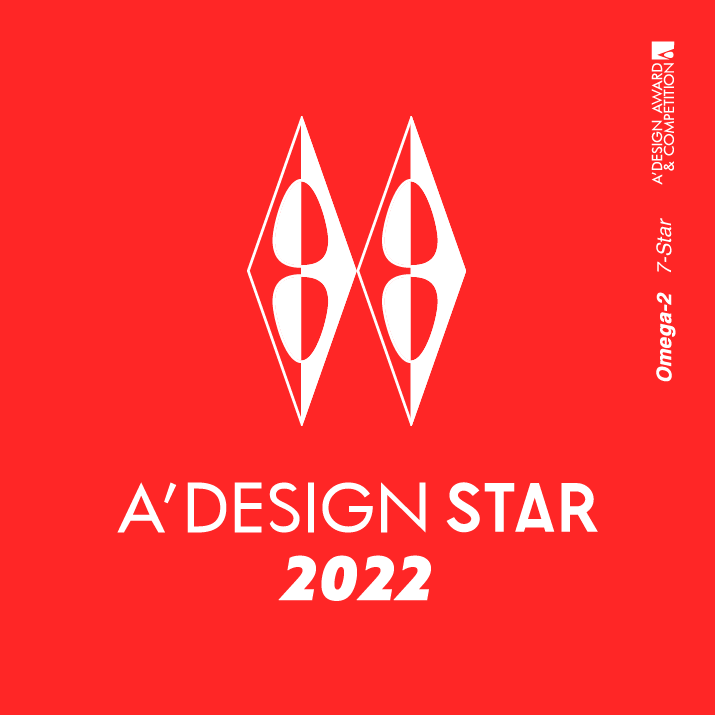
Even, better is the Omega-2 (7-Stars) designation that indicates highly superior, time-proven, repeat great success, exceptional design capabilities. Highly Distinguished Master Designers with Omega-2 designation are almost always deliver the most outstanding and truly exceptional works of art, design, architecture and innovation that not only impresses clients, consumers and customers; but also creates a strong emotional response, resulting in remarkable projects that stand out in the best possible manner.
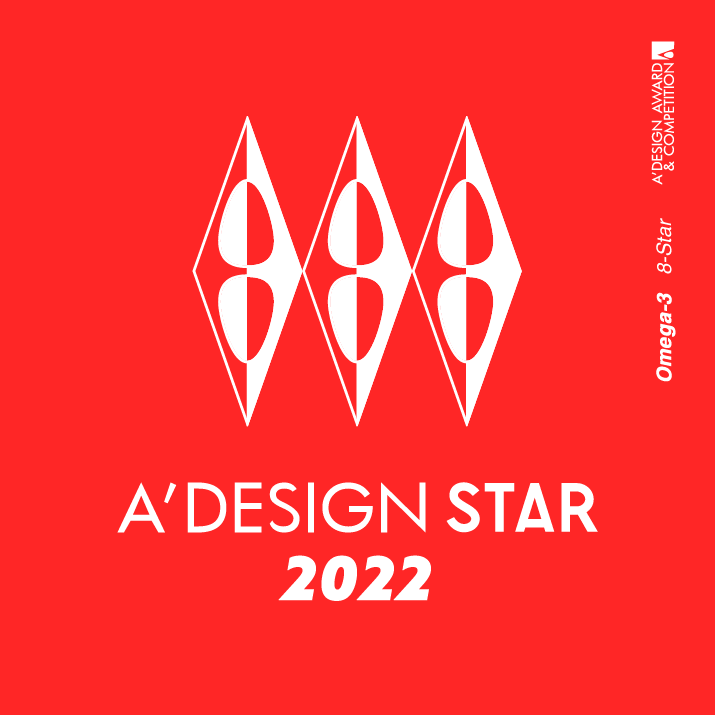
Finally, at the zenith, there is the Omega-3 (8-Stars) designation is the final frontier in design, it indicates time-proven, repeat grand success, phenomenal, unparalleled, World-class design capabilities but also first-rate professionalism and magnificent creativity. Exalted Distinguished Grand Master Designers with Omega-3 rating almost always deliver heirloom designs, transcendent art, landmark projects, star architecture, supreme innovations, most meritorious ideas and distinctive innovations that form strong emotional bonds with clients, consumers, customers and audiences far and beyond.
Working with Omega-1, Omega-2 or Omega-3 level designers, artists, architects, creators and innovators can define whether you make it or break it. Omega-1, Omega-2 or Omega-3 level designers are truly exceptional, outstanding and top-notch creators that will definitely play a very important role in realizing your ideas, creating the highest bang for your buck and driving the most potential out of your seed idea.
The acquisition of an A’ Design Star is designated to create dramatic effects on the success of a design business. A’ Design Star designated famous designers, artists, architects, creators and innovators are published annually in a special guide reserved for CEOs of large brands, government representatives, enterprises and businesses. View the A’ Design Star Guide and find the most excellent designers, artists, architects and creators to work with. Visit now adesignstar.com for an up-to-date listing of all starred designers, their regions and ratings, and have a chance to work with the World’s leading designers, star architects, top-innovators and creatives.
Obtaining A’ Design Star Designation infographics, communication materials, wall signs and certificates are possible from A’ Design Award’s Control Panel. If you are a repeat winner of A’ Design Award & Competition, please kindly visit A’ Design Star management and data access page to see if you have been assigned any A’ Design Star designation. Please kindly note that only 5-Star (Omega-0), 6-Star (Omega-1), 7-Star (Omega-2) and 8-Star (Omega-3) rank recipients are allowed to publicly use their assigned A’ Design Star status for communicating their excellence publicly.
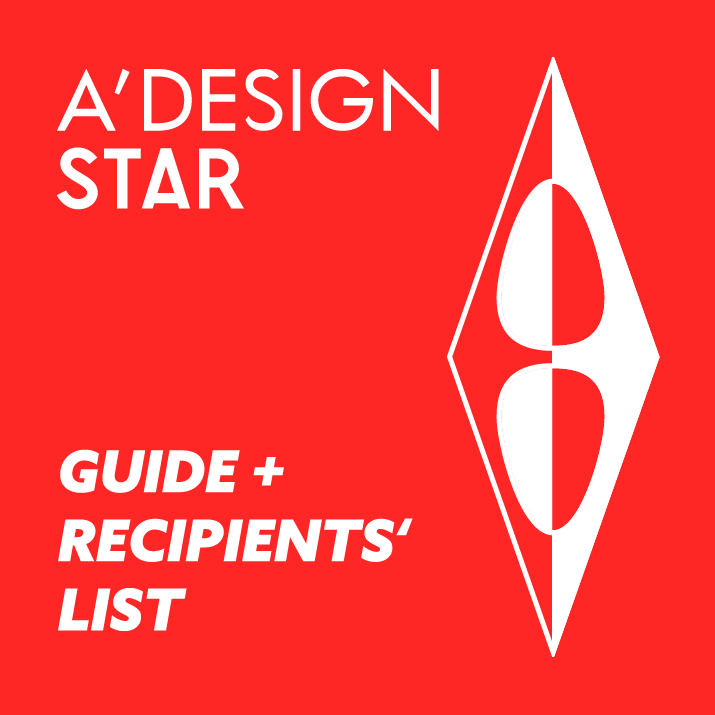
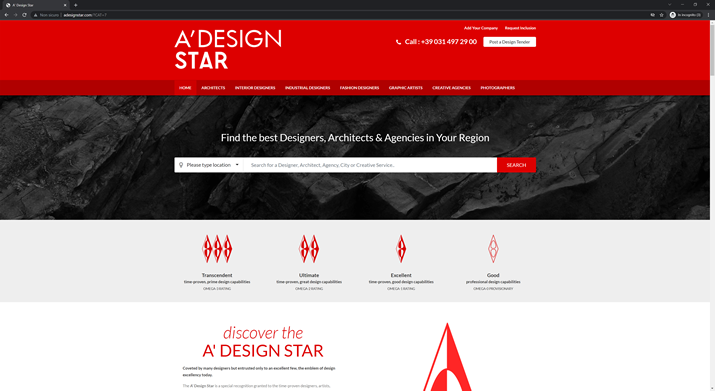
Updated every year, A’ Design Star is special insignia to symbolize excellence in design industry. A’ Design Star is not given; it is earned. It takes years to obtain the A’ Design Star. A’ Design Stars are bestowed to an entity after following a series of anonymous peer-review evaluations by leading designers, artists, architects and innovators, within a three-year period. A’ Design Star and it’s Omega Ratings are always personal; the A’ Design Star is always given to a creative individual, artist, architect or designer, that is in most cases to the lead designer, chief architect, principle creative or master craftsman of a design establishment, however honourable Design Star Designations are possible; in general, when a business talks about their A’ Design Star rating, they refer to their honourable designation that comes from their designers. Discover more at A' Design Star Guide + Recipients' List website.
A' Design Star Emblem Implementation
The suggested way to use the A' Design Star emblem is indeed to physically embed them into exteriors of design studios, architectural offices, artists workshops and creative agencies, to better communicate star ratings and ignite a conversation with clients, consumers, customers and buyers. The physical emblem should be printed on Acrylic (Plexiglass) 250 mm x 250 mm x 5 mm Panels (that is a square panel with 25 cm height and 25 cm width with 5mm thickness) with Glossy Finish with White Opaque Printing. Colors need to be vivid, for outdoor usage special paint or coating suggested for UV protection. For digital use, on the other hand, A' Design Star infographic and digital signage is provided with a slightly different variant artwork where the institution, design studio, artist's workshop, architecture office or the creative agency name is noted more prominently on the panel. Mind that both versions of the A' Design Star emblem features the institution name, city and country. Enterprises and Agencies who have branches in different cities are able to request customized emblem for each and every one of their branches, furthermore each and every branch of an agency could be registered to A' Design Star Guide as a distinct entry, which helps with discovery.
 |
 |
 |
Above, A' Design Star Digital Signage and Infographics examples for web usage are shown.
 |
 |
 |
Above, A' Design Star 25 cm x 25 cm Wall Signage for Physical Implementation examples are shown.
Honourable A’ Design Star Designation
A’ Design Star designated designers, artists, architects, creators and innovators are able to grant Honourable A’ Design Star designation to their hosting institutions. When a designer is awarded with any of the prominent A’ Design Star designations such as Omega-1, Omega-2 or Omage-3, with the explicit request and permission by the A’ Design Star designated designer, the business or institution employing the awarded designer can also use the A’ Design Star’s Omega designations to communicate its most exceptional design capabilities, as long as the awarded designer works at least eight months in the employing institution. This is called Honourable A’ Design Star designation. The moment the institution no longer employs the A’ Design Star designated designers; these institutions lose their Honourable A’ Design Star designations immediately within the end of four-month grace period unless such institutions hire another designer with an equivalent A’ Design Star designation.
A' Design Star Special Recognition
Obtaining the A' Design Star honors offers a multitude of benefits, significantly increasing industry visibility and recognition, which can attract potential clients, collaborators, and media attention. The prestigious A' Design Star recognition enhances marketing strategies, amplifies brand equity, and allows for higher service pricing due to the increased demand. A' Design Star opens global exposure opportunities, networking possibilities with industry professionals, and attracts media coverage for additional publicity. The A' Design Star is designed to signal high design quality with an aim to increase market value and brand prestige, potentially triggering governmental financial support, and influence new design trends. A' Design Star also fosters trust among clients and the broader audience, facilitates global collaborations, and acts as a credibility signal for potential investors. Furthermore, A' Design Star contributes to a designer's legacy, provides competitive differentiation, redefines the value perception of design, boosts social media influence, attracts top industry talent, drives innovation, and validates a designer's skill and creativity.
- Recognition & Visibility:
The A' Design Star platform provides a prestigious showcase for the work of designers and brands. Winning such a high-profile recognition can significantly boost visibility in the industry, attracting the attention of potential clients, collaborators, and media. This visibility could lead to an increase in demand for their services. Additionally, from a social psychology perspective, recognition often leads to higher self-esteem and motivation, driving further creativity and productivity.
- Marketing Opportunities:
The credibility associated with A' Design Star can be leveraged in marketing strategies, bolstering promotional campaigns with a recognized stamp of quality. The concept of social proof is relevant here – potential clients are more likely to trust and select services that have been validated by a respected third party.
- Pricing Power:
From a simple supply and demand standpoint, increased visibility and recognition can lead to an increase in demand for a designer's work. As demand increases, designers with A' Design Star recognition can justify higher pricing for their services.
- Brand Equity Enhancement:
Recognition from a respected institution can significantly enhance a brand's value. The prestigious association with A' Design Star can increase perceived value, customer loyalty, and consumer preference, all of which can strengthen the brand's position in the market.
- Networking Opportunities:
A' Design Star serves as a gathering point for high-level professionals in the industry, creating an environment conducive to forming beneficial connections. By being part of this community, designers and brands have the opportunity to build partnerships that could lead to collaborations, shared resources, or even new business opportunities.
- Communicate Design Quality:
Achieving recognition from a prestigious award signifies a high level of design quality. This can serve as a reliable indicator of competence for potential clients, reducing uncertainty in their decision-making process – a concept known as heuristic simplification.
- Global Exposure:
The international reach of the A' Design Star can introduce designers and brands to markets they may not have had access to otherwise. This global visibility can lead to new business opportunities and a diversification of their client base.
- Media Attention:
High-profile recognitions like the A' Design Star often attract media attention. This provides an opportunity for free publicity and further amplifies the recognition and visibility gained. This concept is often referred to as the "halo effect," where positive impressions in one area (winning a prestigious award such as the A' Design Awards and obtaining the A' Design Star recognition) influence positive impressions in another (media coverage).
- Increasing Market Value:
Obtaining a prestigious recognition like the A' Design Star can increase the perceived value of a designer's work. The economic principle of signaling is at play here – the recognition signals a high level of quality and can help winners justify higher pricing in the market.
- Brand Prestige:
Being associated with a highly esteemed design award and good design recognition is expected to increase a brand's prestige. This can have a halo effect, enhancing all aspects of the brand and creating a positive perception among consumers, clients, and peers.
- Government Support:
Governments usually aim to enhance their cultural, environmental, and economic status. Hence, when a designer’s work aligns with these initiatives, the recognition from a platform like A’ Design Star signals to the government the potential societal value of the designer's work. This can trigger financial support in terms of grants and subsidies, as it can be seen as an investment towards achieving the government's strategic objectives.
- Marketing Amplification:
A’ Design Star recognition is designed to increase winner's visibility and attracting attention from potential clients and customers, based on the halo effect in social psychology, where the prestige of the award can enhance the perceived value of the designer's work, creating additional marketing opportunities.
- Attracting New Business Opportunities:
Businesses seek to associate with high-quality, award-winning designers to boost their own credibility, as driven by the principle of social proof, which suggests that people tend to follow the actions of others when making decisions. In this case, the A’ Design Star recognition can be seen as a testament to a designer's skill and capability, attracting potential business partners.
- Influence on Design Trends:
Being recognized by A’ Design Star provides designers with a platform that amplifies their voice in their field. In the context of the diffusion of innovations theory, these designers could be seen as opinion leaders, driving new design trends and influencing others in their industry.
- Increased Trust:
A' Design Awards is designed to signify quality and competence, A' Design Star takes it a level higher by recognizing repeat and recent success. The principle of authority, a concept in psychology, suggests that people tend to trust and follow recognized authorities or experts. In this case, brands associated with award-winning designers can leverage this trust to increase customer loyalty and improve sales.
- Global Citizen Recognition:
The A’ Design Star's international scope and prestige can facilitate the recognition of designers as global citizens. This recognition could provide access to international projects and collaborations, contributing to the global marketplace's "flattening," a term coined by Thomas Friedman to describe the increasing ease with which individuals can collaborate and compete globally.
- Credibility for Funding and Investments:
Investors and financiers often rely on signals to assess the potential success of an investment. A' Design Star recognition could serve as such a signal, indicating that the designer or firm possesses a level of expertise and quality that could lead to future success, based on the signaling theory in economics.
- Establishing Design Legacies:
Recognition platforms like A’ Design Star help document and promote designers' work. This builds a historical record, contributing to the designers' legacy. The kind of recognition provided by the A' Design Star recognition can be seen as a form of cultural capital, a term coined by Pierre Bourdieu to describe non-financial social assets that promote social mobility.
- Competitive Advantage:
Achieving an A' Design Star can differentiate a designer from their competitors. In terms of Porter's competitive strategy theory, this could be seen as a form of differentiation strategy, which involves distinguishing products or services using unique features to attract a specific market segment.
- Redefining Value:
Recognitions like the A' Design Star can challenge and shift public perception about the value of design, encouraging consumers to value the design process and its outcomes more. Thus A' Design Star could help you increase demand or price of your services based on the concept of value-based pricing, where price is determined by the perceived value of the product or service.
- Social Media Influence:
In today's digital age, social media is a powerful tool for building a personal brand and influence. Recognition from the A' Design Star can boost a designer's social media presence and influence, utilizing the bandwagon effect, a phenomenon where people tend to align their beliefs and behaviors with those of a group or trend.
- Social Proof:
With the A' Design Star, designers can showcase their design proficiency to potential clients and consumers. The award serves as social proof, a psychological phenomenon where people assume the actions of others in an attempt to reflect correct behavior in a given situation. Winning the award communicates to others that the designer is accepted by industry experts, which influences how potential clients perceive them.
- Attracting Talent:
High-level recognition can make a brand or designer more attractive to top talent. In a competitive industry, having a strong reputation can be a deciding factor for job seekers. This concept aligns with the Attraction-Selection-Attrition framework, which suggests that organizations attract individuals who fit their context.
- Innovation Drive:
Winning the award can serve as a motivation for continuous innovation. Recognition is a powerful motivational tool that can push designers to strive for further creativity and ingenuity in their work. Obtaining the A' Design Star and maintaining an active designation can be a great drive towards innovation.
- Increased Trust:
Winning a recognition like the A' Design Star can significantly increase the trust potential clients have in a designer's ability. Trust is a crucial component in business relationships, and this recognition can serve as an excellent foundation for that trust.
- Validation of Skill:
The A' Design Star validates a designer's skill and creativity, with an emphasis on repeat and recent success. This specific validation can boost designers' confidence and credibility in the industry, leading to more opportunities and success in their field, as well as more respect by media, journalists, consumers and clients.

A' Design Award and Competition has been designed to recognize and award outstanding designers, artists and architects via ethical and fair judging procedure by a Grand Jury Panel.

